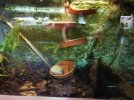- Messages
- 736
- Location
- Clarkston, WA
Yours are looking more like C. compta as shown on Tom's web page.
Mine were more like C. eigenmenni or C. nigrofasciata.
Your Copella grew to become quite pretty.
Mine were more like C. eigenmenni or C. nigrofasciata.
Your Copella grew to become quite pretty.

